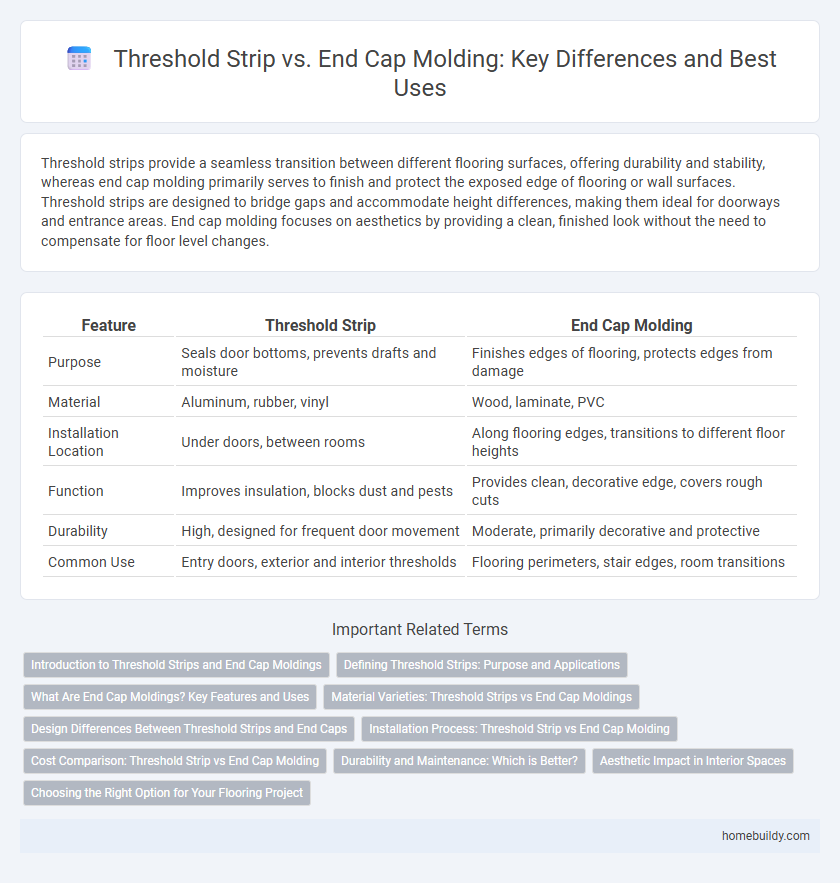Threshold strips provide a seamless transition between different flooring surfaces, offering durability and stability, whereas end cap molding primarily serves to finish and protect the exposed edge of flooring or wall surfaces. Threshold strips are designed to bridge gaps and accommodate height differences, making them ideal for doorways and entrance areas. End cap molding focuses on aesthetics by providing a clean, finished look without the need to compensate for floor level changes.
Table of Comparison
| Feature | Threshold Strip | End Cap Molding |
|---|---|---|
| Purpose | Seals door bottoms, prevents drafts and moisture | Finishes edges of flooring, protects edges from damage |
| Material | Aluminum, rubber, vinyl | Wood, laminate, PVC |
| Installation Location | Under doors, between rooms | Along flooring edges, transitions to different floor heights |
| Function | Improves insulation, blocks dust and pests | Provides clean, decorative edge, covers rough cuts |
| Durability | High, designed for frequent door movement | Moderate, primarily decorative and protective |
| Common Use | Entry doors, exterior and interior thresholds | Flooring perimeters, stair edges, room transitions |
Introduction to Threshold Strips and End Cap Moldings
Threshold strips provide a durable transition between different flooring surfaces, ensuring a smooth and safe passage while preventing wear and damage. End cap moldings function as finishing elements that cap the exposed edges of flooring, offering a clean and polished look while securing the floor's perimeter. Both components play essential roles in flooring installation by enhancing durability, safety, and aesthetic appeal.
Defining Threshold Strips: Purpose and Applications
Threshold strips serve as transition pieces installed between different flooring types to provide a smooth, safe passage and to cover expansion gaps. They are essential in enhancing floor durability, preventing trip hazards, and offering aesthetic continuity in doorways and room transitions. End cap moldings primarily finish the exposed edges of flooring, especially at walls or stopping points, but lack the transitional function and gap coverage that threshold strips provide.
What Are End Cap Moldings? Key Features and Uses
End cap moldings serve as finishing trims designed to neatly terminate threshold edges where flooring meets door jambs or walls, providing a clean and polished transition. Key features include their versatility in accommodating various flooring materials such as hardwood, laminate, and tile, along with their ability to conceal uneven or rough cuts at floor edges. Commonly used in both residential and commercial spaces, end cap moldings enhance aesthetic appeal while preventing tripping hazards and protecting floor edges from wear and damage.
Material Varieties: Threshold Strips vs End Cap Moldings
Threshold strips commonly use durable materials such as aluminum, wood, rubber, and vinyl, designed to withstand heavy foot traffic and provide seamless floor transitions. End cap moldings often utilize flexible materials like PVC, rubber, or wood, tailored for capping the exposed edges of flooring for a polished finish. The choice of material impacts durability, flexibility, and aesthetic compatibility in flooring installations between threshold strips and end cap moldings.
Design Differences Between Threshold Strips and End Caps
Threshold strips are typically wider and designed to bridge gaps between different flooring types, providing a smooth transition and accommodating height variations. End cap moldings are narrower with a defined edge, primarily used to finish the exposed edges of flooring where it meets walls or other vertical surfaces. The design of threshold strips emphasizes durability and cushioning to withstand foot traffic, while end caps prioritize aesthetic edge sealing and clean termination of flooring installations.
Installation Process: Threshold Strip vs End Cap Molding
Threshold strips are installed by anchoring them directly to the floor using screws or adhesive, creating a secure transition between different flooring surfaces. End cap molding, on the other hand, is typically attached to wall edges or the end of flooring panels using nails or adhesive, providing a finished look where flooring ends meet vertical surfaces. The installation of threshold strips requires precise measurements to ensure a seamless floor-to-floor connection, while end cap molding focuses more on aesthetic trimming and edge protection.
Cost Comparison: Threshold Strip vs End Cap Molding
Threshold strips generally offer a more affordable solution compared to end cap molding, with prices averaging 20-30% lower per linear foot. The simpler installation process of threshold strips also reduces labor costs, making them a budget-friendly choice for flooring transitions. End cap molding, while potentially more durable and decorative, often incurs higher material and installation expenses due to its complex design and custom fitting requirements.
Durability and Maintenance: Which is Better?
Threshold strips typically offer greater durability due to their solid construction with materials like aluminum or rubber, providing long-lasting resistance to wear and heavy foot traffic. End cap moldings, often made from softer materials such as vinyl or plastic, may require more frequent maintenance and replacement when exposed to harsh conditions or frequent use. Overall, threshold strips tend to be a better choice for high-traffic areas demanding minimal upkeep and extended lifespan.
Aesthetic Impact in Interior Spaces
Threshold strips create a seamless transition between flooring types while maintaining a minimalist aesthetic, enhancing the overall visual flow of interior spaces. End cap moldings provide a distinct boundary that highlights the edge of flooring installations, adding a defined architectural detail. Choosing between the two impacts interior design by either promoting continuity with threshold strips or emphasizing contrast with end cap moldings for tailored aesthetic effects.
Choosing the Right Option for Your Flooring Project
Threshold strips provide a seamless transition between different flooring types and levels, ensuring safety and enhancing durability in high-traffic areas. End cap moldings finish the edge of flooring where it meets vertical surfaces, preventing damage and providing a clean, polished look. Selecting between threshold strips and end cap moldings depends on the specific flooring layout, transition requirements, and aesthetic preferences of your project.
Threshold strip vs End cap molding Infographic

 homebuildy.com
homebuildy.com